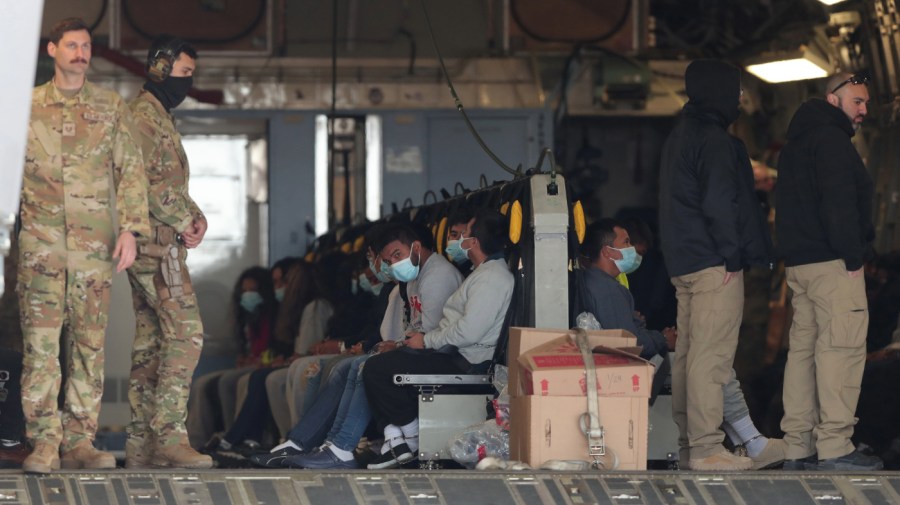
Once again, the phrase “shock and awe” has become popular — this time in describing the Trump administration’s efforts to remove the “worst of the worst” illegal immigrants arrested for certain crimes.
As the principal creator of the shock and awe military doctrine, dating back to 1995, I am here to tell you that the effort to expel these individuals is many things — among them, justified — but it is not “shock and awe.”
Shock was the first intensive reaction generated by our actions. Awe was the means of extending shock for an extended period.
The first misuse of shock and awe came during the Iraq War in March 2003. As the coalition began its offensive against Saddam Hussein, Gen. Tommy Franks, the overall commander, announced a campaign of “shock and awe” was underway.
Franks had been given the book on shock and awe by then-Secretary of Defense Donald Rumsfeld. Rumsfeld was a “rump” member of the team that helped invent shock and awe eight years before.
Rather than read the book, Franks grabbed the headline. On the second day of the onslaught, the United Kingdom’s Daily Telegraph ran a half-page prominently displayed photo of bombs exploding in Baghdad under the headline “Baghdad Blitz.” Shock and awe “disappeared” that day.
What had been the catalyst for “shock and awe” was a combination of Operation Desert Storm and the 1991 Iraq War — in which the world’s sixth largest Army was driven from Kuwait and in 100 hours eviscerated — and the theories of Chinese general and philosopher Sun Tzu, who argued for winning without fighting. Given the massive military superiority of the U.S.-led force in the Gulf, I wondered whether it might not have been used more decisively.
This question led me to form a small group of retired four-star officers who had commanded the air, sea and land components of Desert Storm, along with a very senior former Defense Department civilian. The answer we formulated was that strategic objectives must be based on the ability to use all kinetic and non-kinetic tools to affect, influence and control the will and perception of potential adversaries with a minimum use of force.
Rumsfeld, who became an unofficial member of the group, summarized this in basic terms of “getting the other fellow to do what you want or stop doing what you do not want.”
Shock and awe had four characteristics. The first was to control all aspects of the environment and the land, air, sea, space and cyber domains, meaning that the adversary would see or perceive exactly what we intended and not see whatever we wanted withheld.
Second was as complete knowledge and understanding of the environment and the adversary as possible. Since all the military members of the group had served in Vietnam, we understood how the failure to know and understand the enemy had lost us the war.
Third was rapidity and the necessity of acting far more quickly than the adversary. Last was brilliance in operations as the only acceptable standard in execution of the strategy. Technologies for each of these characteristics were part of “shock and awe.”
Ten levels of shock and awe were identified. The first was the equivalent of winning the lottery and the positive aspects of shock and awe to gain control. The most decisive was how nuclear weapons forced the Japanese to abandon suicidal resistance and accept unconditional surrender.
The intent of shock and awe was to render the adversary impotent to taking any action and hence being entirely vulnerable to our will.
That did not mean nuclear weapons were the only or best means to achieve shock and awe. Conventional bombing of Tokyo, Nagoya and Haruna killed more Japanese civilians than the atomic bombs in Hiroshima or Nagasaki.
But the Japanese could not comprehend how two bombs from two aircraft could wreak so much destruction and death. That was shock and awe at work, and it ended the war.
Gen. Colin Powell developed the idea of overwhelming force that became “decisive force.” The crucial difference between that and shock and awe is that military force may or may not have been necessary. Instead, the psychological aspects were crucial to the concept of shock and awe.
Obviously, rounding up illegal immigrants arrested for crimes does not fall under shock and awe. The phrase has simply become too commonplace. The premise of aiming to affect, influence and control will and perception must be the key to a strategy of shock and awe.
Just think how it could be applied to our adversaries today.
Harlan Ullman, Ph.D., is United Press International’s Arnaud deBorchgrave Distinguished Columnist, senior advisor at Washington’s Atlantic Council, chairman of two private companies and principal author of the shock and awe military doctrine. His next book, due in 2025, is “The Great Paradox: Strategic Thinking in an Unstrategic World.”











